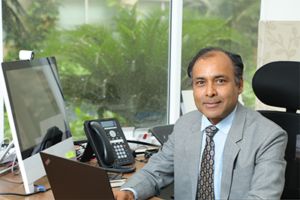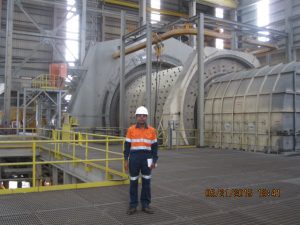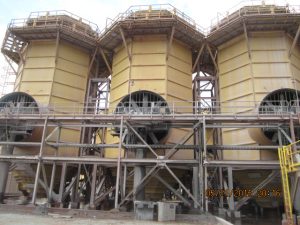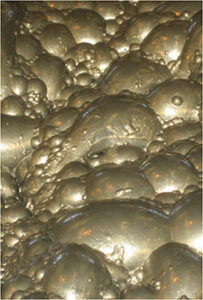
About ORE2METAL
ORE2METAL is a provider of advanced eco-efficient technologies for production of strategic and precious metals in collaboration with its partners focussing on value chain support from project scoping & feasibility to plant design and commissioning. Ore2Metal specialises in metals recovery from complex ore bodies as well as from mine tailings, smelter residues and electronic waste.
Three key focus areas of Ore2Metal Inc.

1. Strategic and Precious Metals:
Building plants involving our technology partners for production of high purity strategic and precious metals from complex ore bodies and also from mining, smelting and electronic waste.

2. Greenfield Project Feasibility:
Conduct scoping and feasibility studies including design, engineering and techno-economic analysis for strategic and precious metals projects

3. Operations Optimization:
• Conduct audits & road mapping for implementation of step-change improvement projects from Ore to Metal.
• Supplier of environmentally friendly chemicals and activated carbon along with downstream processing expertise to optimize metals recovery and concentrate quality.
 1. Strategic & Precious Metals
1. Strategic & Precious Metals
Building plants involving our technology partners for production of high purity strategic and precious metals from complex ore bodies and also from mining, smelting and electronic waste.
Economic growth for most nations now hinges on its ability to sustain its long-term goals of urbanization, access to energy, infrastructure development, national security, medical, and poverty reduction. This will inevitably result in an unprecedented strain on natural resources and environment. The energy sector is expected to experience a gradual shift towards renewable sources in the coming decades due to climate change as well as energy security issues. The promotion of energy efficiency and renewable energy sources relies on related innovative high technologies, including solar electricity, wind power, fuel cells, batteries, electrolysis, hydrogen storages, electric cars and energy efficient lighting. Development of these technologies requires a number of critical and strategic metals including Antimony (Sb), Cobalt (Co), Gallium (Ga), Germanium (Ge), Indium (in), Lithium (Li), Niobium (Nb), Nickel (Ni), Platinum Group Metals (PGMs), Rare Earth Elements (REEs), Selenium (Se) and Tellurium (Te).
Although these elements are often not geologically concentrated enough to be prospected and mined on their own, they are oftentimes thinly distributed and co-deposited with metals such as lead, zinc, copper and aluminum. Thus, primary metals which are produced at the multimillion tonnes per year level can potentially provide enough capacity (hundreds or thousands of tonnes) to meet annual consumption of the strategic metals. These elements are increasingly strategic to growing economies because their absence can preclude participation in certain products; and their shortage may be restrictive to technical development. In most cases, control of these elements provides significant commercial leverage beyond the actual, apparent value of the elements.
The metallurgical industry with respect to copper, zinc, lead, aluminium, chromite and gold has an untapped source of strategic elements which are typically not recovered. The minor metals are generally contained in tailings and residue streams and discarded as waste or sold for a fraction of the actual value.
-
Copper industry loses a host a range of valuable minor metals in tailings and residues such as Co, Se, Te, Ag, Au, PGM’s and Fe.
-
Zinc and Lead industry loses various minor metals in tailings and residues including In, Ga, Ge, Bi, Ag and Fe.
-
Aluminum industry loses Ga, V and rare earths in red mud after bauxite processing.
-
Chromite operations lose a significant amount of Ni and PGM’s
-
Gold industries lose various heavy rare earths and other strategic metals depending on type of deposits.
Ore2Metal and its partners carry out scoping and feasibility studies to identify the best technology for optimum solution to our client’s specific needs. Based on the outcome, we carry out a detailed techno-economic analysis to assist our client in providing the necessary information to enable their business decision. Once the project is approved for commercialisation, Ore2Metal and its partners carry out detailed design and engineering all the way to building the plant and commissioning.
 2. Greenfield Project Feasibility
2. Greenfield Project Feasibility
Conduct scoping and feasibility studies including design, engineering and techno-economic analysis for strategic and precious metals projects
Ores bodies are increasingly becoming more complex. Use of conventional and off-the-shelf technologies are not normally effective in making them economical due to significant capital requirements, higher operating costs, poor metal recoveries and massive waste handling needs. Yet, most projects rely on off-the-shelf technologies and traditional design criteria during the initial stages of scoping or prefeasibility studies. Once the design is locked in, any major shift in technology adoption becomes very challenging and costly. This is a trap that often leads to an undesirable project outcome.
Technologies have now evolved to an extent that can now be leveraged to transform these marginal deposits into profitable and sustainable ventures. Many of these technologies have been implemented in various operations across the world but in a limited, sporadic and fragmented way, mostly as an after thought. Ore2Metal and its global partner’s significant global experience in implementing new technologies has now allowed a systematic approach to integrate all these innovations for a holistic and robust solutions customized to these complex deposits.
Ore2Metal’s approach is to bring in breakthrough ideas early on in the project along with necessary benchmarking with conventional approaches and technologies. The ability to reject ideas that don’t suit the project right in its early stages is a powerful step towards adoption of the most suited technologies for optimum solution. This saves time and also avoids traps or mistakes that could be costly if not identified early in the process.
Ore2Metal and its partners provide support during the scoping and feasibility stages along with any technology validation or metallurgical test work (bench and piloting) required to identify design criteria for engineering and construction.
Technologies have now advanced to an extent that the minerals and metals lost in the tailings, after processing, can now be recovered economically. This, however, requires tremendous insight and know-how of diagnostic mineralogy along with innovative processing routes to improve and maximize recovery. Metals such as iron in pyrite, that are conventionally discarded to flotation tailings or stored as jarosite residues, could now be recovered thus alleviating many of the ongoing environment concerns across the globe. It is important to note that this also allows recovery of many precious and minor metals presently lost in various waste streams in milling and smelting operations.
Ore2Metal Inc. has embarked on a major journey to assist operations in their recovery improvement drive leveraging the 3T’s (techniques, technologies and training) to address these ongoing recovery challenges.
Ore2Metal and its global partner’s significant experience suggests that many flotation tailings containing precious, minor and rare earth metal values can now be recovered effectively using a novel integrated Concentration & HydroMet technology, with a high recovery potential that is cost effective, environmentally friendly and sustainable. Waste to Wealth is a real possibility now.
 3. Operations Optimization:
3. Operations Optimization:
-
Conduct audits & road mapping for implementation of step-change improvement projects from Ore to Metal.
-
Supplier of environmentally friendly chemicals and activated carbon along with downstream processing expertise to optimize metals recovery and concentrate quality.
The trend of lower metal recovery in mills & concentrators is on the rise in most gold, copper and other base metals operations leading to significant wastage of valuable resources, thus raising serious questions about our ability or approach to address sustainability. 15 to 20% metal losses of major metals are increasingly becoming common along with deteriorating concentrate quality. In addition, most operations don’t have a strategy or their process plants not designed to recover various precious or highly valuable minor metals that are mostly lost in tailings.
Technologies have now advanced to an extent that the minerals and metals lost in the tailings, after processing, can now be recovered economically. This, however, requires tremendous insight and know-how of diagnostic mineralogy along with innovative processing routes to improve and maximize recovery. Metals such as iron in pyrite, that are conventionally discarded to flotation tailings or stored as jarosite residues, could now be recovered thus alleviating many of the ongoing environment concerns across the globe. It is important to note that this also allows recovery of many precious and minor metals presently lost in various waste streams in milling and smelting operations.
Ore2Metal Inc. has embarked on a major journey to assist operations in their recovery improvement drive leveraging the 3T’s (techniques, technologies and training) to address these ongoing recovery challenges.
Ore2Metal’s MillART (Mill Advanced Recovery Technologies)
Ore2Metal leverages its MillART approach to improve recovery in operations. This involves use of specialised environmentally friendly reagents and activated carbon to optimize metallurgy. The aim is to provide a clean mill chemistry, a selective low alkaline flotation system and optimum bank operating profiles along with a process control strategy that involves all three for optimum flotation performance.
Unique Approach to creating wealth from complex ores and waste: – Leveraging the 3 pillars
1. Domain Expertise
 Ore2Metal focusses on a value chain approach to maximize the value from an ore deposit or from an existing operation. Often targeting value in isolation such as focusing only on Mill recoveries results in solutions that are not optimum and hard to sustain in the long run. For example, one may optimize mill grind target and flotation recovery for a certain ore type, but the gains could easily diminish if variability in ore type, mineralogy or mining ore dilution start to play a key role, and this happens quite frequently in many mining operations. Ore2Metal Inc. focuses on integrating domain expertise in advanced geometallurgy, mining, preconcentration, comminution, flotation, extractive metallurgy and waste management to develop robust and sustaining solutions. Ore2Metal and its partners have developed proprietary technologies to recover waste from mine tailings and smelter residues. Ore2Metal’s systematic approach to solutions focuses on lower capital, minimize waste generation, higher recovery, lower operating cost and environmentally sustainable solution.
Ore2Metal focusses on a value chain approach to maximize the value from an ore deposit or from an existing operation. Often targeting value in isolation such as focusing only on Mill recoveries results in solutions that are not optimum and hard to sustain in the long run. For example, one may optimize mill grind target and flotation recovery for a certain ore type, but the gains could easily diminish if variability in ore type, mineralogy or mining ore dilution start to play a key role, and this happens quite frequently in many mining operations. Ore2Metal Inc. focuses on integrating domain expertise in advanced geometallurgy, mining, preconcentration, comminution, flotation, extractive metallurgy and waste management to develop robust and sustaining solutions. Ore2Metal and its partners have developed proprietary technologies to recover waste from mine tailings and smelter residues. Ore2Metal’s systematic approach to solutions focuses on lower capital, minimize waste generation, higher recovery, lower operating cost and environmentally sustainable solution.
2. Digital

Though digital in only an enabler, but it has a powerful impact when coupled with the right domain expertise. With out domain technical knowhow digital on its own has minimal impact in mining.
The digital era is upon us and it is imperative that we leverage digital whether it’s sensors technologies to measure operational parameters or data analytics or modelling of our unit operations along with the value chain from mining ore to metal production. Predictive capability along with artificial intelligence is becoming important whether we gear ourselves to optimize operations or to predict failures or breakdowns from an asset optimization point of view.
Digital way of working in mining operations is already leading to significant improvements in production efficiency and effectiveness. This is resulting in new operational models where the integrated planning, real time monitoring, control, data analytics and improvement roles are carried out virtually from anywhere in the world. Site based roles are only limited to certain operational tasks and preventive maintenance activities, now even these activities are increasingly being automated.
Minimizing manual interventions and man-machine interactions in operations through digitalization is key to driving safety, productivity and reliability. Maximizing value from ores is only possible when the principles of digitalization are blended with domain expertise.
This is an area where Ore2Metal and its partners provide unique expertise to the mining industry with digital twin capability of an operation leveraging decades of experience in developing fundamental yet practical models for unit operations ranging from blast fragmentation, comminution, flotation and extractive metallurgy.
3. Sustainable Mining
 Sustaining the benefits of any value improvement program through domain know-how and digital expertise is strategic to the business needs of any mining company. This requires a systematic approach to education and training of operating personnel along with successful technology transfer. Challenges such as declining ore grades, increasing complexities of ore bodies along with dwindling skilled operational personnel only make it even more important to emphasize on enhancing technical and management skills-set. In addition, drive for innovation and breakthroughs is vital to developing solutions for myriad of challenges in mining, not just from ore variability viewpoint, but also from issues such as tailings management, energy and water shortages along with corporate social responsibilities. Mining generates a significant amount of waste and it is time we question our existing mining paradigm “why do we need to generate waste in the first place”. There are new technologies we can embrace such as rejecting waste right at the mining face and the use of waste for mine backfill, along with other novel technologies such as Insitu or Inplace metal recovery. Reducing our mining footprint with minimal energy and water requirements makes good business sense along with enhancing our chances of “license to operate”. It is time we imbibe corporate social innovation and not just focus on corporate social responsibility. This is only possible when we leverage the 3 pillars of maximizing value from ores.
Sustaining the benefits of any value improvement program through domain know-how and digital expertise is strategic to the business needs of any mining company. This requires a systematic approach to education and training of operating personnel along with successful technology transfer. Challenges such as declining ore grades, increasing complexities of ore bodies along with dwindling skilled operational personnel only make it even more important to emphasize on enhancing technical and management skills-set. In addition, drive for innovation and breakthroughs is vital to developing solutions for myriad of challenges in mining, not just from ore variability viewpoint, but also from issues such as tailings management, energy and water shortages along with corporate social responsibilities. Mining generates a significant amount of waste and it is time we question our existing mining paradigm “why do we need to generate waste in the first place”. There are new technologies we can embrace such as rejecting waste right at the mining face and the use of waste for mine backfill, along with other novel technologies such as Insitu or Inplace metal recovery. Reducing our mining footprint with minimal energy and water requirements makes good business sense along with enhancing our chances of “license to operate”. It is time we imbibe corporate social innovation and not just focus on corporate social responsibility. This is only possible when we leverage the 3 pillars of maximizing value from ores.
